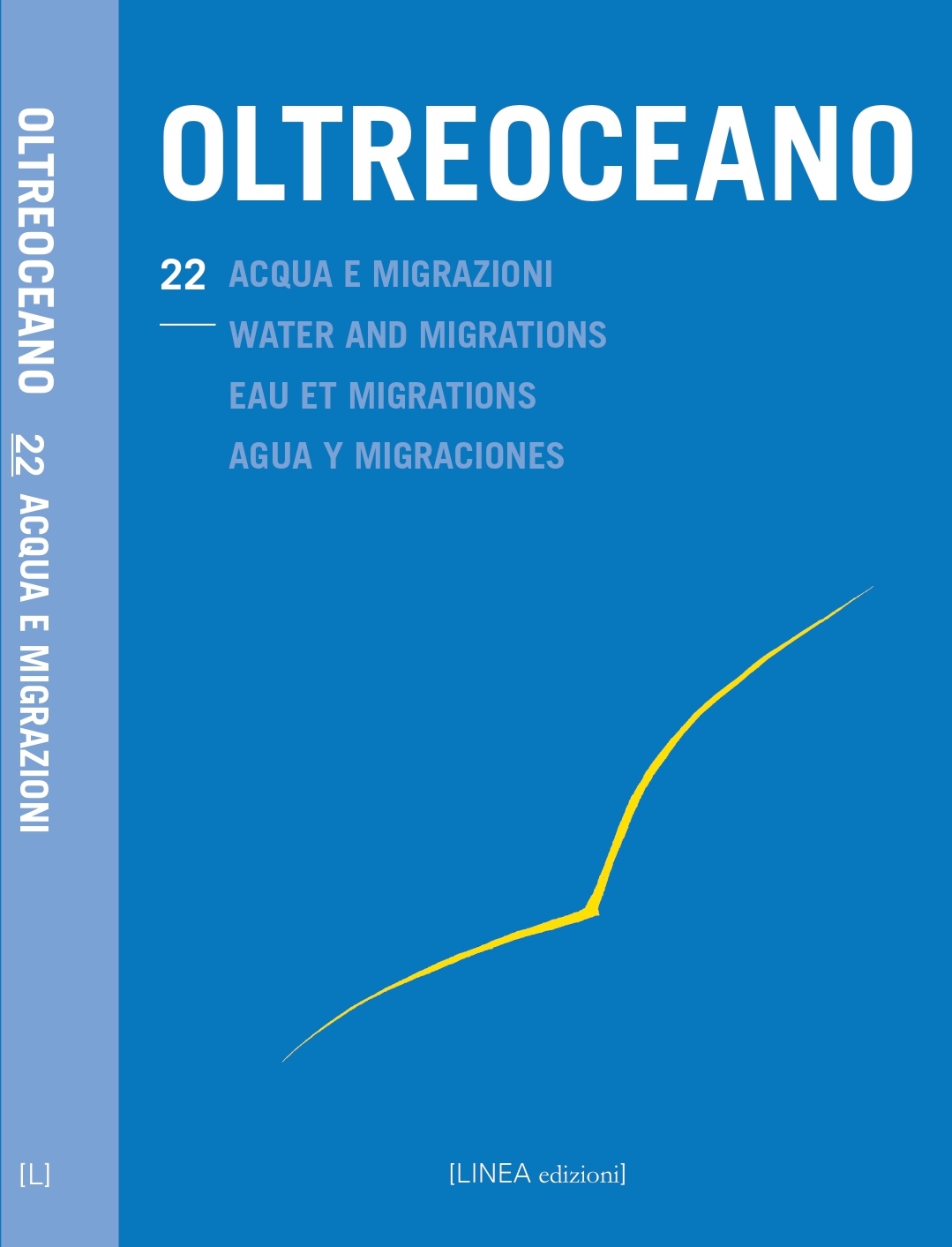Hermetic polysemy of water in the oneiro-iconopoems of the Surrealists Benoît and Bounoure
DOI:
https://doi.org/10.53154/Oltreoceano87Keywords:
Vincent Bounoure, Vincent BounoureEnvers l'ombre, Surrealism, IconotextAbstract
This essay aims at highlighting the aquatic occurrences in some poems by the French Surrealist poet Vincent Bounoure, illustrated by the Quebecois artist Jean Benoît. Starting from a brief presentation of the latter, the article draws attention to the phenomenon of reverse emigration: rather than the well-known migration from Europe to North America, it focuses on Benoît’s choice to leave the conservative milieu of Quebec and move to Paris with his wife Mimi Parent in the late 1940s. This eastward emigration across the Atlantic was fruitful for the couple, who was welcomed into the Parisian group of the Surrealist movement, then still animated by its founder, André Breton; some years after his death, they also helped Vincent Bounoure continue the Surrealist activities, against Jean Schuster’s attempt to consider them finished in 1969. A year before Breton’s death, Benoît and Bounoure published a work entitled Envers l’ombre (1965), which consists of fourteen poems by Bounoure with some illustrations by Benoît. Our analysis will first offer some elements for an iconotextual philological reconstruction of how this work was produced, by also taking into account some unpublished documents from Bounoure’s archives. It will then offer an interpretation of those iconotexts which, either in Bounoure’s poems, in Benoît’s images or in both, evoke some references to water. Attention will be focused, in particular, on the hermetic interpretative clue indispensable for the polysemic understanding of these watery references in Bounoure’s poems and their analogical transfiguration in Benoît’s illustrations; finally, we propose to call these texts “oneiric iconopoems”.
Downloads
References
Bédouin, J.-L. (1977): La Poésie surréaliste, 1964. Paris: Seghers.
Bettini, M. (1998): Il racconto di Alcmena salvata dalla donnola. In M. Bettini, Nascere. Storie di donne, donnole, madri ed eroi (pp. 47-218). Torino: Einaudi.
Borduas, P.-É. & al. (1948): Refus global. Recuperato da http://conseildesarts.org/documents/Manisfeste/manifeste_ refus.htm (Visitato il 19/03/2023).
Bounoure, V. (1958): Préface à un traité des matrices. Le surréalisme, même, 4, pp. 12-25 (ora anche in V. Bounoure, Moments du surréalisme. Paris: L’Harmattan, 1999, pp. 92-113).
Bounoure, V. (1962, inedito): Manoscritti e dattiloscritti preparatori di Sceptre e Respective per Envers l’ombre, 6 fogli.
Bounoure, V. (1965): Envers l’ombre. Illustrations de J. Benoît. Paris: Éditions surréalistes.
Bounoure, V. (1967): La Peinture américaine. Lausanne: Rencontre. G. Veronesi (Trad. it. 1969), La pittura americana. Milano: il Saggiatore.
Breton, A. (1965): Enfin Jean Benoît nous rend le grand cérémonial. In Le Surréalisme et la peinture (pp. 386-390). Paris: Gallimard.
Caduto, M. J. & Bruchac, J. (1997): How Fisher went to the Skyland. The Origin of the Big Dipper. In M. J. Caduto & J. Bruchac (Ed.), Keepers of the Earth (pp. 117-120). Golden: Fulcrum Publishing.
Clark, C. (2008): Potawatomy Astrology. HowNiKan, 28, 3, pp. 4-5.
Cliquet, M. (2022): Martre. In M. Cliquet (Ed.), Grimoire de symbolisme totémique. Tome 1. Les animaux de pouvoir (pp. 665-666). Recuperato da https://regisliber.files.wordpress.com/2022/12/ttm1.pdf (Visitato il 30/04/2023).
Gagnon, F.-M. (Ed.) (1972): Paul-Émile Borduas – Projections libérantes. Études françaises, 8, 3.
Gagnon, F.-M. (1998): Chronique du mouvement automatiste québécois 1941-1954. Québec: Lanctôt.
Gichtel, J. G. (1897): Theosophia practica, traduite pour la première fois en français. Paris: Chamuel.
Graves, R. (2005): I miti greci. Milano: Loganesi & C.
Judson, K. B. (2000): Ojeeg, the Summer-Maker: Ojibwa. In K. B. Judson (Ed.), Native American Legends of the Great Lakes and the Mississippi Valley (pp. 106-109). DeKalb: Northern Illinois University Press.
Lapointe, G. & Michaud, G. (Eds.) (1998): L’automatisme en mouvement. Études françaises, 34, 2-3.
Leland, C. G. (1885): How the Partridge built Good Canoes for all the Birds, and a Bad One for Himself. In C. G. Leland (Ed.), The Algonquin Legends of New England (pp. 293-295). Boston: Houghton, Mifflin and Company.
Ovidio (2000): Le Metamorfosi, 1471. In Ovidio, Opere, II (pp. 1-1646). L. Galasso (Ed.). Torino: Einaudi.
Plinio il Vecchio (1469): Naturalis historiæ, 77 d.C. Recuperato da https://penelope.uchicago.edu/Thayer/I/Roman/Texts/ Pliny_the_Elder/home*.html (Visitato il 19/03/2023).
Ripa, C. (1630): Iconologia, ampliata dal Sig. Cav. Gio. Zaratino Castellini. Padova: Pasquardi.
Speck, F. G. (1915): Origin of the Constellation Fisher (Ursa Major). In F. G. Speck (Ed.), Myths and Folk-Lore of the Timiskaming Algonquin and Timagami Ojibwa (pp. 63-64). Ottawa: Government Printing Bureau.
Teocrito (2020): Idillio XXIV: Eracle bambino, 270 a.C. In Teocrito, Idilli ed epigrammi (pp. 240-249). Milano: La vita felice.
Tonnancour, J. de & al. (1948): Prisme d’yeux. Recuperato da http://conseildesarts.org/documents/Manisfeste/manifeste_ prisme_dyeux.htm (Visitato il 19/03/2023).
Downloads
Published
How to Cite
Issue
Section
License

This work is licensed under a Creative Commons Attribution-NonCommercial-ShareAlike 4.0 International License.
The authors undertake to comply with the following conditions, which are considered accepted at the time of submission of their contributions.
The sending of a text implies that it is unpublished and not submitted to be published elsewhere.
1. If accepted, the author shall confer on the publisher the right to publish and distribute it both in paper form and in the online electronic edition. The published articles will be downloadable and made available in open access.
2. Provided that it correctly indicates that the first publication took place in the journal Oltreoceano. Rivista sulle migrazioni the author has the right to: a) reproduce the article in separate extracts or collected in a volume; b) publish the article on their personal website or teaching site provided that these sites are of a non-commercial nature; c) deposit the article in online archives of a non-commercial nature, linked to the institution they belong to or as part of projects for the non-commercial dissemination and open access of scientific works.
The use of contributions by third parties, for commercial or otherwise unauthorized purposes, is not allowed. The publisher declines all responsibility for the unauthorized use of the material published in the journal.












